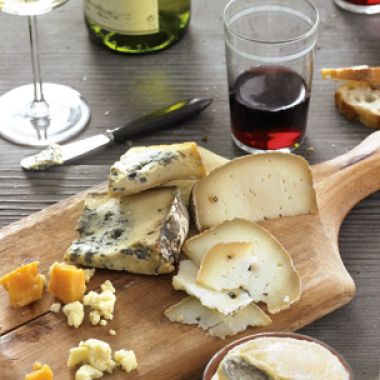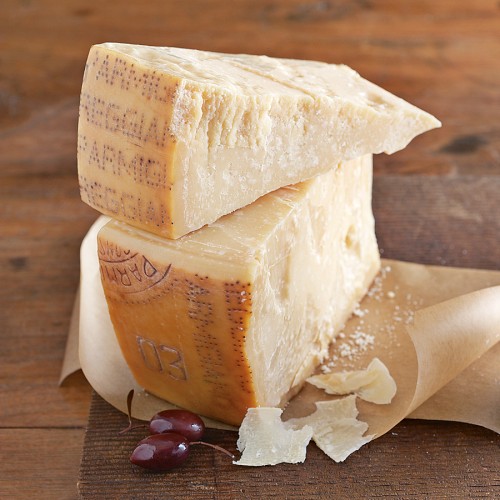
CHEESE
There's more to pairing cheese and wine than you might think. Many cheeses are too strong to match with fine or mature red wine. In fact, white wines are often better with cheese than reds. Sweet white wines, in particular, taste good with sharp, salty blue-veined cheeses.
Blue Cheeses
The great blue-veined cheeses, such as French Roquefort, are a classic with Sauternes or a late-harvest California Sauvignon Blanc. Stilton is good with a mature tawny or vintage port. Spain's Cabrales matches well with dry Oloroso sherry or a mature red Rioja. Gorgonzola calls for a big red wine, such as a Barolo from Italy or an Australian Shiraz.
Brie/Camembert
A younger tawny port is a good match with these velvety, soft-ripened and triple-cream cheeses, as are fruity young red wines, such as Pinot Noir from California's Russian River Valley or a good Beaujolais.
Cheddar
This type of firm, often sharp cheese pairs well with late-harvest Sauvignon Blanc, Oloroso sherry or a good vintage port. Red Bordeaux wine and cheddar is a combination to be avoided.
Goat's Milk Cheeses
There is a wide range of goat cheeses, but in general they have strong flavors and are well paired with Sancerre from France, late-harvest Sauvignon Blanc from California, Sauternes, and mature tawny ports and lighter vintage ports.
Gouda
An aged gouda matches very well with a mature Bordeaux wine or California Cabernet Sauvignon.
Manchego
This classic Spanish cheese makes a good combination with vintage port, sweet Muscat or even a fruity Zinfandel.
Parmigiano-Reggiano
Match this strongly flavored cheese with a big Italian red wine, such as Barolo or a reserve Chianti, or try a mature California Cabernet Sauvignon.
Pecorino
Match the nutty flavor of this firm Italian sheep's milk cheese with Zinfandel, a lighter Rhône red wine or sherry.
DESSERTS
There is a respected school of thought that believes a good sweet wine—what the Australians call a sticky—is dessert, and anything more is too much of a good thing. To get the best flavors from a great dessert wine, whether a Sauternes, Madeira, old sherry or port, it is best to taste it on its own or perhaps with a simple cheese course. However, if you want to drink wine with dessert, the general rule is to choose a wine that is slightly sweeter than the dessert. Fruity desserts need a sweet wine with acidity. Some chocolate desserts can go well with port.
Cheesecake
Oloroso sherry, Madeira or ruby port would all be good choices.
Chocolate
Serve a tawny port, or go for a different approach and try a mature California Cabernet Sauvignon (a wine that often has chocolate traces in the flavor).
Crème Brûlée
Serve cream sherry, Madeira or a sweet Muscat—for example, Muscat de Beaumes de Venise from France.
Fresh Berries
Try Monbazillac from France or a semidry German Riesling.
Fresh Fruit
Serve a dry sparkling rosé, dry Alsace Riesling or a fruity young white, such as Viognier from California or an Italian Frascati.
Fruit Pies
An off-dry Riesling from Washington state or Oregon should work.
Tiramisù
Serve a sweet sherry or ruby port with this Italian dessert, or try a sparkling Asti from Italy.
Zabaglione
Serve sweet Marsala (the wine used to make the dessert) or sweet Riesling from Germany or Washington state. Ruby port would also work well.
Adapted from The Wine Guide (Time-Life Books, 1999)
Related Tips:
Recommended Products
- $69.95
- $79.95














